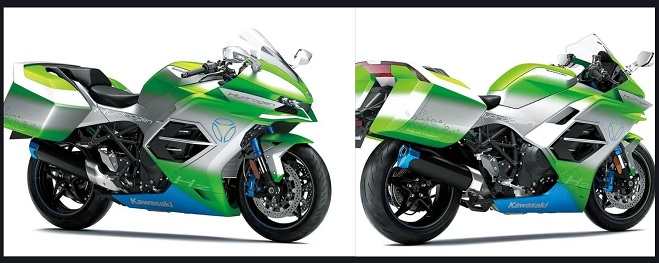Kawasaki finalizes the development of its first hydrogen motorcycle
Kawasaki, a motorcycle company, has chosen a name and logo for its upcoming hydrogen-powered motorcycle. The name of the motorcycle is HySE, and the logo has a drop of water and two circles.

However, it is important to note that despite being a hydrogen-powered motorcycle, the application for the name and logo has been submitted for non-electric vehicles. That means a motorcycle will not use a fuel cell to power an electric motor. Instead, it will use an internal combustion engine, similar to a traditional gasoline-powered motorcycle.
The HySE motorcycle from Kawasaki will have a four-cylinder engine that can use hydrogen as fuel. The engine will have direct injection and a volumetric compressor, which means it will compress the hydrogen to make it more efficient.
The motorcycle will initially be based on another model from Kawasaki called the Ninja H2 SX. However, it is expected that the HySE will have a different appearance from the Ninja H2 SX and improved aerodynamics to make it more efficient.
Towards the end of last year, Kawasaki showed a prototype of the HySE motorcycle called the “Ninja H2 Hydrogen.” This prototype gives us an idea of what the final HySE motorcycle might look like when it is released next year.
The Ninja H2 Hydrogen was painted in a striking tricolor scheme of green, gray, and blue. It is a powerful 999 cubic centimeter engine that produces up to 200 horsepower.
The Ninja H2 Hydrogen prototype had some “suitcases” located at the back of the motorcycle. These suitcases were designed to store up to five hydrogen cylinders, which are used as fuel for the engine.
The cylinders can be removed and exchanged for pre-loaded ones, which makes refueling faster and easier. Kawasaki says that also makes the motorcycle safer in case of an accident because the hydrogen cylinders can be quickly removed and do not pose a risk of explosion.
Kawasaki will launch its first hydrogen motorcycle from 2024

Kawasaki is planning to release its first hydrogen-powered motorcycle starting in 2024. However, there are still several unknowns that need to be addressed, especially since internal combustion engines that use hydrogen are not very efficient.
In addition, hydrogen-powered vehicles require large tanks to achieve a competitive range, which raises questions about whether this solution will be viable for motorcycles. Nevertheless, Kawasaki may have a solution to this problem by using liquefied hydrogen instead. That could potentially make the storage of hydrogen more compact and efficient, making it a more viable option for the motorcycle industry.
Some other manufacturers, like Toyota, are also exploring the use of liquid hydrogen for their vehicles. The advantage of using liquid hydrogen is to reduce the fuel tank.
It must be cooled to a low temperature of -252.87 ºC to keep hydrogen in a liquid state, which is costly and requires specialized equipment. As a result, many people predict that hydrogen-powered internal combustion engines may not be very successful in the light transportation industry due to the challenges associated with storing and handling liquid hydrogen.
Kawasaki plans to release its first hydrogen motorcycle on the market in 2024, although an exact date has not been announced yet. However, since there is still a lack of refueling infrastructure for hydrogen-powered vehicles, the release may be slow, and the first shipments might be intended for test fleets. That means it may take some time for hydrogen motorcycles to become widely available to the general public, as the necessary infrastructure for refueling and maintenance needs to be developed first.
Related Post
